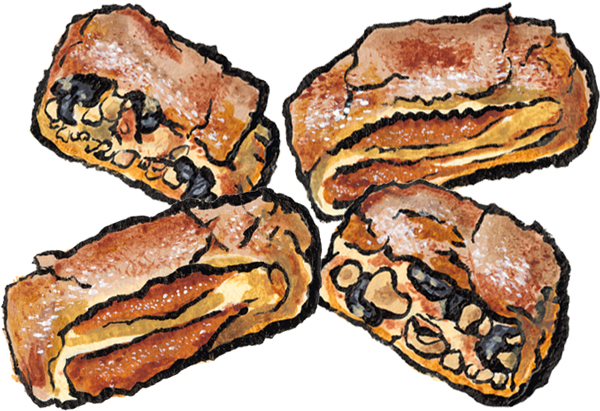The story of rugelach, the most popular Jewish pastry in America, dates back several hundred years to a Viennese cookie called kipfel (incidentally, also the ancestor of Hungary’s kifli). “Kipfel” means crescent, the cookie’s shape; “rugelach” probably comes from the Yiddish word rog, or corner—so rugelach is “little corners.”
Throughout history, as Jews moved they brought their food traditions and adapted them to make use of new local ingredients. At the end of the 19th century, many Jews fleeing the pogroms of Russia and eastern Europe arrived to the lower East side of Manhattan. Within a couple of generations schmaltz spread on dark rye bread had been replaced by schmear on a bagel. The story of rugelach is no different. When Jews made rugelach in the old country, they would have been pareve—that is, prepared with no dairy or meat—so that they could be served as dessert on the Sabbath or on holidays. But in New York, they had new ingredients to play with, like cream cheese.
Today, most American rugelach is made with a Philadelphia cream cheese dough.
How do we know cream cheese dough wasn’t an old Yiddish tradition? Simple. It didn’t exist. The cream cheese we know today got its start on a farm in upstate New York in the 1870s. To cash in on the trend of the day for French soft cheeses, some American dairy farmers started making a soft, fresh cheese that we might call farmer’s cheese today. One pioneering farmer named William Lawrence got the idea that he could make his cheese even richer by adding a bit of cream to it. He called it cream cheese, and to distinguish it from the other soft cheeses of the time, he gave it a square shape. It took off, and by 1880 he had opened a factory on a nearby farm.
Soon Lawrence began working with Alvah Reynolds, who used his horse and wagon to peddle cheese in the streets of New York City. Reynolds had two brilliant ideas. First, he suggested that each cheese should be individually wrapped in foil that was branded. That doesn’t sound so special today, but at the time most folks bought their goods from bulk supplies at general stores. Cases delivered to the store might have a brand, but the products themselves did not. Now for the first time the public was starting to see brand names in the store. With that change came the dawn of brand loyalty—and Reynolds wanted to build that loyalty. His second idea was that since nobody knew who Lawrence was it shouldn’t be called something like “Lawrence’s Cream Cheese.” Instead, he called it “Philadelphia.” In the 19th century Philly had a reputation as a source for great cheeses, and by using the name Philadelphia they could capitalize on that reputation. The ideas worked. Soon Reynolds’ supply of cheese couldn’t keep up with demand, so he started contracting with other farms and other factories to make cream cheese to his specifications (and then wrapping it in the Philadelphia branded labels that he provided, of course).
At the start of the 20th century Reynolds sold the rights to Philadelphia cream cheese to a company called Phenix, which later went on to merge with Kraft. In 1924 Kraft launched their Home Economics department, which was responsible for developing and publishing recipes using their products. The recipes worked. In a generation cream cheese went from being an unknown oddity to a kitchen staple. Delis started serving New York cheesecake in the 1920s; by the 1940s the trendy new Sunday brunch was bagels, cream cheese, and lox.
Around the same time, second-generation Jewish immigrants in New York were coming of age and starting to cook for their own families. The first published recipe for rugelach appeared in a 1941 cookbook called The Jewish Home Beautiful. The recipe included sour cream, about which the authors said: “The method is not traditional; in fact it is quite modern, but as long as the finished product is just like mother’s, does it matter?” A decade later, that modernization was pushed even further when the first recipe for rugelach made with a cream cheese dough—remarkably similar to a recipe for a cream cheese pie dough published in a Kraft pamphlet distributed at the 1939 World’s Fair—was published in the cookbook The Perfect Hostess. Within a couple of decades, it became the standard. In American rugelach, cream cheese dough was king.
At Zingerman’s Bakehouse, the recipe for rugelach’s cream cheese dough is pretty simple: one third butter, one third (Philadelphia) cream cheese, and one third pastry flour.
There’s a reason that cream cheese dough has stuck around. The cream cheese and butter come together to make an incredibly crisp, flaky pastry that crackles as you bite into it and then melts in your mouth. About as soon as it does, you’re sure to find yourself reaching for another.
That cream cheese dough is wrapped around a filling. Back in the old country, it might have had nuts, dried fruits, poppyseed paste, or jams. While the pastry has changed significantly, in some ways the filling has stayed the same. Our classic rugelach, made with half toasted walnuts and half dried currants, is a combination that great-great-great bubbe back in Austria would recognize immediately. Likewise, apricot and raspberry, filled with really flavorful jams, probably wouldn’t have been too unfamiliar. Chocolate is less traditional, but given that it tastes like a crisp, bite-sized pain au chocolat, I say bring on the modern methods. As long as the finished product tastes this good, does it matter?

